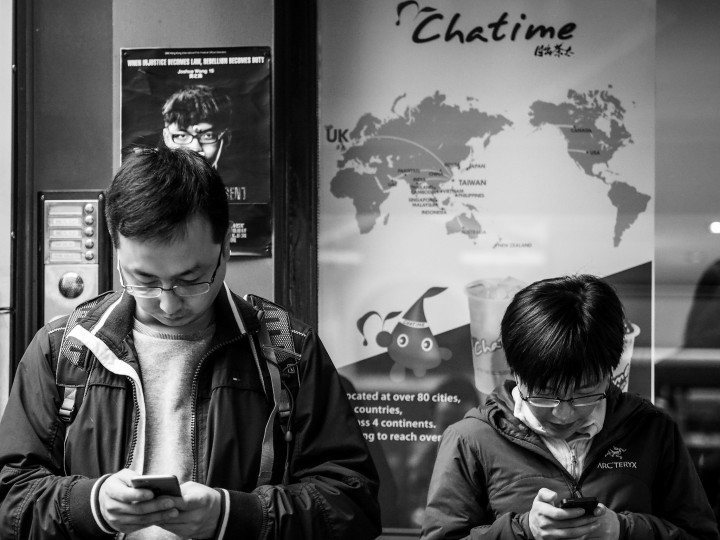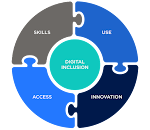
Portable informing has changed the way we live, however I trust we are simply beginning. Having set the tech world buzzing subsequent to January 2015, informing is the enormous meta-pattern of the following couple of years.
The two principle points of interest of informing are that it is (an) offbeat and (b) individual. A voice call constrains you to put off all other portable exercises, yet the offbeat message permits adaptability. You can share documents and contacts, check the news, and have synchronous discussions with others, all in the meantime. In addition, the message imitates how people really interface and you realize that someone else is on the flip side. This is the reason portable informing applications have such high engagement, superior to anything even online networking and amusement applications.
All things considered, the account of the portable message has recently started. Having worked in this field subsequent to August 2014, I see five key patterns that could further change how we utilize the message.
1. Search as a conversation
The conventional web hunt is illsuited to the versatile medium. A portable inquiry should be close to home and logical, instead of hurl 10 connections for a series of decisive words. In reality, the stage is being situated for inquiry applications that consolidate talk. It ought to be the same as having a discussion and a decent sample is Luka, an application that sends AI-fueled talk to help clients discover great spots to eat.
Google Search has likewise been providing so as to take the conversational course direct responses to numerous inquiries and customizing indexed lists in light of clients' pursuit history. It considers connection, as one may in a discussion. With Google Now considering application utilization (e.g. which applications are transparent, what related data may be obliged), list items have turned out to be more client particular. Also, this specificity is relied upon to become once Google Now On Tap enters the brawl, permitting clients to look for data even while drew in with different applications.
2. Consumer-to-business chat to grow
The customary web pursuit is illsuited to the portable medium. A portable hunt should be close to home and logical, instead of hurl 10 connections for a series of magic words. To be sure, the stage is being situated for hunt applications that join visit. It ought to be the same as having a discussion and a decent sample is Luka, an application that conveys AI-fueled talk to help clients discover great spots to eat.
Google Search has likewise been providing so as to take the conversational course direct responses to numerous inquiries and customizing indexed lists taking into account clients' pursuit history. It considers setting, as one may in a discussion. With Google Now considering application use (e.g. which applications are transparent, what related data may be obliged), list items have turned out to be more client particular. What's more, this specificity is required to become once Google Now On Tap enters the fight, permitting clients to look for data even while drew in with different applications.
3. Looks and feels like chat, but isn’t just chat
Mobile messaging apps like WhatsApp started out as free variants of the SMS, but their multimedia support has transformed the mobile message. Besides exchanging text bubbles, users now make voice calls, share images and contacts, and more. Going forward, mobile chat will become more interactive and discreet, in order to facilitate various actions, whether seeking recommendations, making payments and purchases, or playing games.
Hike Messenger achieved this quite successfully during the cricket World Cup earlier this year. The mobile application set up a dedicated chat window to provide users with detailed scorecards of the games, along with related news, polls, and the ability to share updates with other users.
Watch out for further developments in this space, as even global players like WeChat and LINE are unsure about how things could unfold in the realm of customer engagement via message.
4. Greater focus on machine learning
The growth of mobile messaging should give a much-needed fillip to research and development in artificial intelligence (AI), machine learning (ML), and natural language processing (NLP), among others. Although the marginal utility of diverting more resources into these areas drops sharply at present, increased focus on these technologies will help messaging apps to scale up and find success.
People already access various kinds of information on a web browser. For example, when you land on an Amazon product page, it is something of a conversation (although not in so many words): ‘Hello, Ankur. Here’s the Dell laptop you were looking at and here are its features. Our other users love it and have rated it 4.3. If you don’t like it, we have these other related options for you to check out!’ Chat could make this exchange seamless by deploying NLP and ML. With repeated use, the app’s ability to comprehend the user’s needs and preferences would improve.
5. Peer-to-peer chat will get unbundled
As messaging becomes the preferred method of communication, users are no longer bound to a single big platform like Facebook. The social landscape is getting fragmented and different apps are funnelling different kinds of conversation.
A range of interactions—with friends, co-workers, and businesses—flow through Facebook Messenger and WhatsApp, while younger users turn to Snapchat and Instagram. For more professionally oriented conversations, Slack is gaining ground, powered by its knowledge base, repository, and focus on privacy.
These distinctions should become sharper over time, as users find specific apps to send the desired message in the right way.
The continued evolution of mobile messaging is a direct result of how messaging apps have transformed our use of mobile devices: The voice call has given way to the message and mobile web users are increasingly choosing to message rather than browse. In the coming years, expect to see smarter and more intuitive messaging that offers a wider range of functionalities and powers higher customer engagement than ever before.
3. Looks and feels like chat, but isn’t just chat
Mobile messaging apps like WhatsApp started out as free variants of the SMS, but their multimedia support has transformed the mobile message. Besides exchanging text bubbles, users now make voice calls, share images and contacts, and more. Going forward, mobile chat will become more interactive and discreet, in order to facilitate various actions, whether seeking recommendations, making payments and purchases, or playing games.
Hike Messenger achieved this quite successfully during the cricket World Cup earlier this year. The mobile application set up a dedicated chat window to provide users with detailed scorecards of the games, along with related news, polls, and the ability to share updates with other users.
Watch out for further developments in this space, as even global players like WeChat and LINE are unsure about how things could unfold in the realm of customer engagement via message.
4. Greater focus on machine learning
The growth of mobile messaging should give a much-needed fillip to research and development in artificial intelligence (AI), machine learning (ML), and natural language processing (NLP), among others. Although the marginal utility of diverting more resources into these areas drops sharply at present, increased focus on these technologies will help messaging apps to scale up and find success.
People already access various kinds of information on a web browser. For example, when you land on an Amazon product page, it is something of a conversation (although not in so many words): ‘Hello, Ankur. Here’s the Dell laptop you were looking at and here are its features. Our other users love it and have rated it 4.3. If you don’t like it, we have these other related options for you to check out!’ Chat could make this exchange seamless by deploying NLP and ML. With repeated use, the app’s ability to comprehend the user’s needs and preferences would improve.
5. Peer-to-peer chat will get unbundled
As messaging becomes the preferred method of communication, users are no longer bound to a single big platform like Facebook. The social landscape is getting fragmented and different apps are funnelling different kinds of conversation.
A range of interactions—with friends, co-workers, and businesses—flow through Facebook Messenger and WhatsApp, while younger users turn to Snapchat and Instagram. For more professionally oriented conversations, Slack is gaining ground, powered by its knowledge base, repository, and focus on privacy.
These distinctions should become sharper over time, as users find specific apps to send the desired message in the right way.
The continued evolution of mobile messaging is a direct result of how messaging apps have transformed our use of mobile devices: The voice call has given way to the message and mobile web users are increasingly choosing to message rather than browse. In the coming years, expect to see smarter and more intuitive messaging that offers a wider range of functionalities and powers higher customer engagement than ever before.
3. Looks and feels like chat, but isn’t just chat
Mobile messaging apps like WhatsApp started out as free variants of the SMS, but their multimedia support has transformed the mobile message. Besides exchanging text bubbles, users now make voice calls, share images and contacts, and more. Going forward, mobile chat will become more interactive and discreet, in order to facilitate various actions, whether seeking recommendations, making payments and purchases, or playing games.
Hike Messenger achieved this quite successfully during the cricket World Cup earlier this year. The mobile application set up a dedicated chat window to provide users with detailed scorecards of the games, along with related news, polls, and the ability to share updates with other users.
Watch out for further developments in this space, as even global players like WeChat and LINE are unsure about how things could unfold in the realm of customer engagement via message.
4. Greater focus on machine learning
The growth of mobile messaging should give a much-needed fillip to research and development in artificial intelligence (AI), machine learning (ML), and natural language processing (NLP), among others. Although the marginal utility of diverting more resources into these areas drops sharply at present, increased focus on these technologies will help messaging apps to scale up and find success.
People already access various kinds of information on a web browser. For example, when you land on an Amazon product page, it is something of a conversation (although not in so many words): ‘Hello, Ankur. Here’s the Dell laptop you were looking at and here are its features. Our other users love it and have rated it 4.3. If you don’t like it, we have these other related options for you to check out!’ Chat could make this exchange seamless by deploying NLP and ML. With repeated use, the app’s ability to comprehend the user’s needs and preferences would improve.
5. Peer-to-peer chat will get unbundled
As messaging becomes the preferred method of communication, users are no longer bound to a single big platform like Facebook. The social landscape is getting fragmented and different apps are funnelling different kinds of conversation.
A range of interactions—with friends, co-workers, and businesses—flow through Facebook Messenger and WhatsApp, while younger users turn to Snapchat and Instagram. For more professionally oriented conversations, Slack is gaining ground, powered by its knowledge base, repository, and focus on privacy.
These distinctions should become sharper over time, as users find specific apps to send the desired message in the right way.
The continued evolution of mobile messaging is a direct result of how messaging apps have transformed our use of mobile devices: The voice call has given way to the message and mobile web users are increasingly choosing to message rather than browse. In the coming years, expect to see smarter and more intuitive messaging that offers a wider range of functionalities and powers higher customer engagement than ever before.
